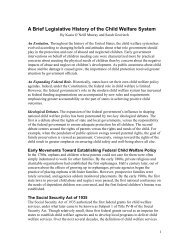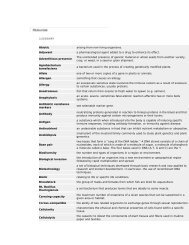Protecting Western Australia's Big Blue Backyard - The Pew ...
Protecting Western Australia's Big Blue Backyard - The Pew ...
Protecting Western Australia's Big Blue Backyard - The Pew ...
You also want an ePaper? Increase the reach of your titles
YUMPU automatically turns print PDFs into web optimized ePapers that Google loves.
LIFE ON THE SHELF<br />
Beyond the Houtman-Abrolhos Islands, the<br />
Leeuwin Current passes by inshore lagoons,<br />
rippled sands, coral reefs, seagrass meadows<br />
and beds of kelp on the Rottnest Shelf.<br />
Stretching from Kalbarri to Cape Leeuwin,<br />
the Rottnest Shelf’s shallow and sheltered<br />
waters—only 50 metres at their deepest—are<br />
protected by submerged limestone ridges and<br />
reefs and influenced by the Leeuwin Current.<br />
<strong>The</strong>y are now recognised as a globally unique<br />
subtropical ecosystem.<br />
Here the low-nutrient waters are clear, light<br />
penetrates further and seagrass and kelp can<br />
grow at greater depths than usual. West Australian<br />
dhufish, pink snapper, breaksea cod, baldchin<br />
groper and the western blue groper use these<br />
areas to feed, breed and grow. <strong>Western</strong> blue<br />
groper can live in these waters for up to 70 years.<br />
Regular visitors to the inshore lagoons of the<br />
Shelf include herring, garfish, tailor and Australian<br />
salmon. <strong>The</strong>y feed on small surface-dwelling fish<br />
and squid and in turn provide food for mulloway,<br />
snapper, samson fish, spanish mackerel and dusky<br />
whaler sharks. Species such as pink snapper live<br />
the early part of their lives in coastal bays and later<br />
move to the shelf edge and over the shelf break.<br />
<strong>The</strong>re, wave energy and water circulation is higher<br />
and food is more abundant.<br />
<strong>The</strong> creation of large no-take marine reserves<br />
would protect the strong connections between<br />
life on and off the Rottnest Shelf.<br />
TROUBLE FOR THE BIG REEF FISH<br />
Overfishing by commercial and recreational fishers<br />
in the Kalbarri to Eucla region is placing enormous<br />
pressure on popular fish species.<br />
<strong>The</strong> West Australian dhufish, pink snapper,<br />
baldchin groper, breaksea cod and red<br />
snapper (also known as bight redfish) have been<br />
dubbed <strong>Western</strong> Australia’s ‘Vulnerable 5’.<br />
<strong>The</strong>ir populations have plummeted and are now<br />
at risk. Other species with the potential to be<br />
added to this ‘at-risk’ list include queen snapper,<br />
western blue groper and red emperor.<br />
<strong>The</strong>ir large size makes these reef fish easy targets<br />
for fishers, while their slow growth and late<br />
maturing give their populations no time to recover.<br />
<strong>The</strong> drop in numbers of the ‘Vulnerable 5’ species<br />
has been greatest in the Perth area. Fishers from<br />
Perth are now travelling further north and south<br />
to find them.<br />
With improved fish-finding technology and gear,<br />
an increasing human population and booming<br />
boat ownership, few areas of the region are now<br />
out of the reach of fishers. <strong>The</strong>re are fewer places<br />
for fish to hide.<br />
<strong>The</strong> number of eggs produced by one<br />
98-centimetre female dhufish is equivalent to<br />
that produced by 11 females of 60 centimetres<br />
in length. <strong>Big</strong>, fat and old females also produce<br />
stronger larvae than younger females, dramatically<br />
increasing their reproductive success. It is<br />
therefore critical to the future of the species that<br />
the larger females are left to spawn. Unfortunately,<br />
the dhufish summer spawning time occurs when<br />
recreational fisher numbers are at their highest.<br />
Although catch and release fishing is on the<br />
increase, most big reef fish are unlikely to survive<br />
this practice. <strong>The</strong> fish, like divers, suffer the bends<br />
during rapid changes in pressure as they are pulled<br />
to the surface.<br />
<strong>The</strong> establishment of a CAR network of large<br />
no-take marine reserves can help the ‘Vulnerable<br />
5’ survive.<br />
DOWN THE CONTINENTAL SLOPE<br />
Washed off the Rottnest Shelf are the broken<br />
blades of seagrass and seaweed and the remains<br />
of dead animals. This is food for life on the<br />
continental slope that begins at a depth of about<br />
200 metres.<br />
Bryozoans (colonies of small animals called zooids),<br />
ascidians (sea squirts), sponges and algae attach<br />
themselves to the sea floor of the continental<br />
slope and provide shelter and food for molluscs,<br />
crystal crabs and sea spiders which are eaten<br />
by blue grenadiers, dogfish and cucumber fish.<br />
Species diversity is high with 480 fish species<br />
identified for the area, of which 31 are found<br />
nowhere else on Earth.<br />
In the deeper waters above the slope a six-metre<br />
megamouth shark might be seen moving towards<br />
the surface to filter feed on shrimp and jellyfish.<br />
<strong>The</strong>se sharks are extremely rare, with only six<br />
specimens ever collected. One of these was found<br />
beached at Mandurah, south of Fremantle,<br />
in August 1988.<br />
A visitor to the continental slope might also<br />
find a toothless Gray’s beaked whale sucking up<br />
deep sea fish and squid, and possibly seastars<br />
and urchins. Little is known about the world’s 21<br />
species of deep-diving beaked whales, but we do<br />
know that half of those species are found in the<br />
Kalbarri to Eucla region.<br />
Down below, on the sea floor of the continental<br />
slope, sponges filter food from the water and<br />
also provide shelter for crustaceans, fish and<br />
seastars, as well as homes for zoanthids and food<br />
for cowries. Scientists believe that sponges could<br />
be the oldest living animal on Earth, with one<br />
specimen thought to be older than 2300 years<br />
of age. Sponges in <strong>Western</strong> Australia are the<br />
‘old-growth forests’ of the sea.<br />
Large sponges have become rare on Australia’s<br />
continental shelf and slope. In some areas they<br />
are completely absent due to trawling. Harrison’s<br />
dogfish and other small deepwater sharks that<br />
live and are caught on the continental slope<br />
have also been seriously affected because they<br />
are long-lived and produce few young. Sea floor<br />
communities and bottom-dwelling fish need the<br />
protection from bottom trawling that large no-take<br />
marine reserves provide.<br />
<strong>The</strong> endemic West Australian<br />
dhufish is one of a number of big<br />
reef fish species under threat from<br />
overfishing by commercial and<br />
recreational fishers<br />
© Glen Cowans<br />
<strong>The</strong> continental slope ends at the abyssal plain.<br />
This huge and mysterious plain covers much of<br />
the region’s sea floor. What weird and wonderful<br />
creatures have adapted to life in the dark, at<br />
depths of more than 5000 metres and with an<br />
immense weight of water upon them? Scientific<br />
discoveries elsewhere provide clues, indicating<br />
that they could include giant sea spiders, deep sea<br />
anglerfish, viperfish, prickly dogfish, frilled sharks,<br />
tripod fish or giant isopods (related to shrimps<br />
and crabs).<br />
Unless we act to protect the continental slope<br />
and abyssal plain, we may never find out what<br />
mysteries lie deep below the waves.<br />
28
















